Although you can train the muscles of the biceps brachii with weights and dumbbells, it’s completely possible to do bicep workouts without weights at home.
In addition to 4 no weight bicep workout routines, we created a list of 9 muscle-building exercises that you can do to beef up your biceps without equipment of any kind.
You’ll also learn how to get bigger biceps without weights or equipment by reading our helpful tips and tricks along the way (hint: Household objects are your best friend when it comes to doing bicep workouts at home).
Related: Triceps workout without weights
The 9 best bicep exercises without weights
Let’s be honest; you probably already know that you can do chin-ups to work your biceps. That’s why we’re showing you how to build your biceps without weights or pull-ups.
All of these muscle-building movements (except for the bonus exercise at the end) make use of simple household objects and your bodyweight to blast your biceps.
1. Water bottle/milk jug bicep curls

Doing bicep curls without weights is easy if you have some large water bottles and milk jugs at your disposal. These containers often have handles so that people can easily carry them out of the store. This design is perfect for your biceps because lifting these jugs at home essentially feels like curling dumbbells at the gym.
Unlike other exercises, you can also implement progressive overload with milk jug bicep curls by emptying liquid to reduce the resistance and adding extra milk/water to make the movement more challenging.
But if you’re really strong and don’t mind making a bit of a mess, then you can even fill your bottles with sand to get bodybuilder-level resistance.
- Hold a pair of heavy water bottles or milk jugs by your sides with a supinated grip.
- Curl the bottles toward your shoulders by flexing your biceps.
- Keep lifting until the undersides of your forearms press right up against your biceps.
- Squeeze your biceps forcefully at the top of the rep for a second.
- Lower the bottles/jugs under control until your elbows reach full extension.
- Repeat for 3-5 sets of 12-20 reps.
2. Backpack bicep curls
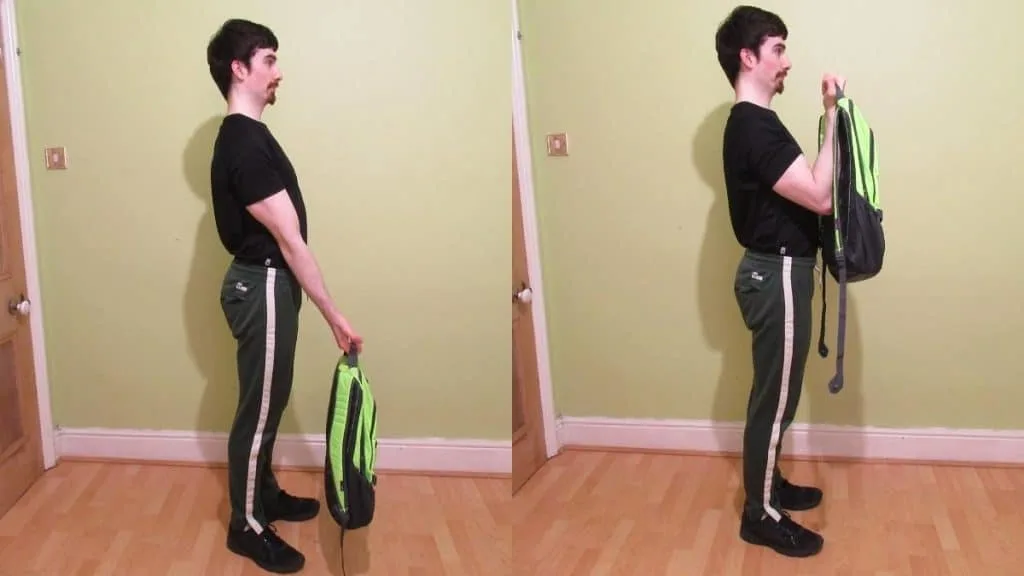
Performing a bicep workout without weights is easy if you have a backpack (the bigger, the better) and some heavy books or groceries. I like to fill my bag with heavy hardbacks and potatoes, but you can literally use anything for resistance (even sand if it’s an old backpack).
Like bottle curls and milk jug curls, backpack curls are one of those no weight bicep exercises that comes naturally to most lifers because the grab handle is so intuitive to hold.
The fact that the handles are typically made from soft fabric means that a) you’re unlikely to get calluses, and b) you can really load up on your backpack curls to fry your fast-twitch muscle fibers.
- Load some heavy household objects into a backpack and zip the bag up.
- Hold the bag by your side with a supinated (palms-up) grip.
- Curl the bag toward your shoulder while keeping your elbow still.
- Keep curling until your forearm and bicep make forceful contact.
- Hold the contraction for a moment, and then lower the bag under control until it’s back at your side.
- Switch arms and perform 3-5 sets of 10-20 reps per side.
3. Inverted curls
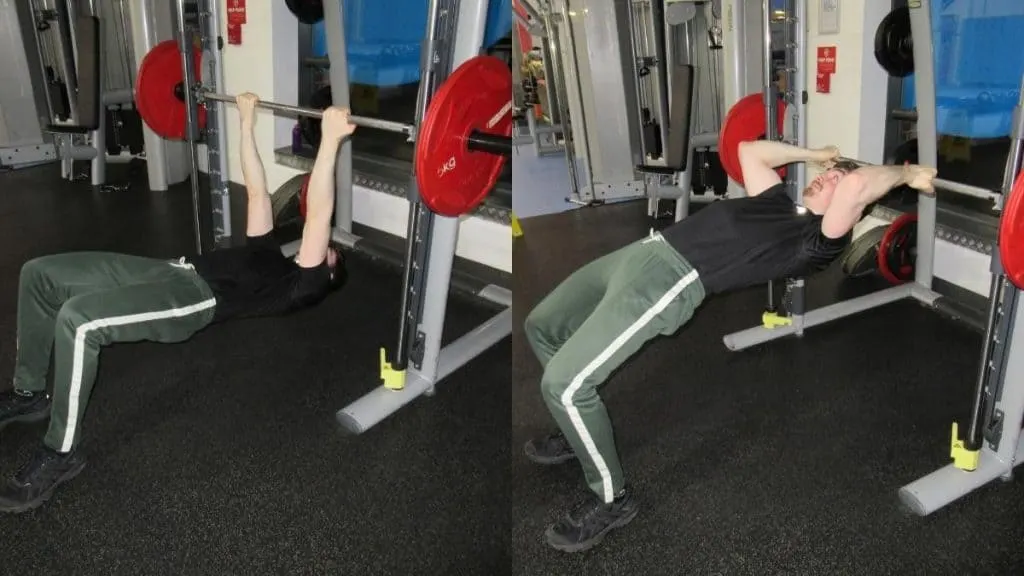
If you want to do bicep workouts without dumbbells or free weights, then the inverted bicep curl is your best bet because it’s a 100% bodyweight movement.
While many people perform this drill by hanging underneath a barbell, you can perform it on any sturdy object such as a table, bed frame, or playground equipment.
But if the regular version is too easy for your bulging biceps, then you can bump up the resistance by wearing a weighted vest or by simply slowing down your reps to make the sets more challenging.
- Position yourself under a sturdy object such as a table or a metal pole.
- Grab the object with a shoulder-width underhand grip and let your elbows extend fully.
- Place your legs out in front of you and plant your feet firmly on the floor.
- Tighten your core and pull your chest to the table/pole/bar by flexing your biceps (avoid using your back).
- Squeeze your biceps forcefully at the top of the rep and then lower your torso under control until your elbows are locked out.
- Increase the difficulty by pulling your head in front of the table/pole/bar rather than just pulling your chest to it.
- Repeat for 3-5 sets of 8-15 reps.
4. Doorway curls
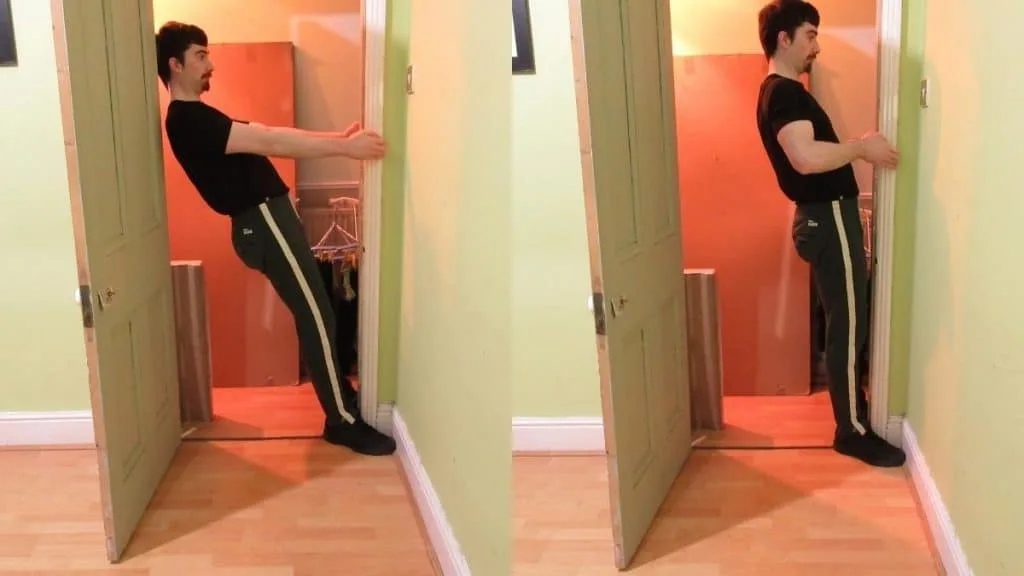
If you want to do a biceps workout at home without equipment of any kind, then the doorway curl is the most obvious and accessible exercise. After all, pretty much everyone has a doorframe that they can grab onto in order to do bicep curls without weights.
Doorway curls are also very versatile. If you can already do sets of 30, then you can instantly double the resistance by performing the movement one arm at a time. This modification will also help you to develop symmetrical biceps since you’ll be training each arm separately.
- Stand in the middle of a doorway and then perform a quarter turn so that you’re facing the side of the doorframe.
- Grab the doorframe, lean your torso back, and shuffle your feet all the way to the bottom of the frame.
- With your elbows fully extended, curl your chest toward the doorframe by flexing your biceps.
- Keep moving until your torso touches the frame or until you can’t contract your biceps anymore.
- Hold the contraction for a second, and then lower your body under control until your arms are locked out.
- Repeat for 3-5 sets of 20-50 reps.
5. Towel curls

The towel curl exercise makes an excellent addition to no weight bicep workouts because it provides a surprisingly high amount of resistance, and you can do it virtually anywhere. And by anywhere, I literally mean anywhere. You could do it in the shower, bathtub—even in an airplane toilet if you wanted. That’s how little space this exercise requires.
Just make sure to lift your leg as high as possible. This drill gets exponentially harder the more contracted your biceps become.
So if you want to get the absolute best bicep workout without weights, then make sure that you’re not performing half reps or wimping out on the peak contraction.
- Grab both ends of a towel and then place the back of your leg in the middle of the towel.
- Lift your leg as high as you can without excessively moving your shoulders.
- Contract your biceps forcefully at the top of the rep.
- Lower your leg slowly and then repeat for 3-5 sets of 15-30 reps.
See also: Bodyweight bicep exercises
6. Vacuum cleaner curls

Your biceps can’t tell whether you’re lifting dumbbells, barbells, or rocks. That’s why any heavy household object that you can easily grab is great for doing a biceps workout without equipment.
Vacuum cleaners are particularly useful for our purposes because they generally weigh enough for biceps curls, and you can grab them in multiple ways to target different regions of your biceps.
For example, holding the long part of the vacuum cleaner with a neutral grip will work your brachialis and brachioradialis in addition to your biceps.
Depending on the particular model, you can also use a supinated grip to focus on your biceps, or you can switch to a reverse grip to put your biceps at a mechanical disadvantage and target your brachialis and brachioradialis muscles instead.
- Grab the vacuum cleaner with one hand.
- Hold the vacuum cleaner either by your side or slightly in front of your thighs.
- Curl the device toward your shoulder while keeping your elbow still.
- Keep lifting until your forearm presses up against your bicep.
- Hold the contraction for a second, and then lower the device under control.
- Switch sides and perform 3-5 sets of 8-20 reps per arm.
7. Bicep push-ups
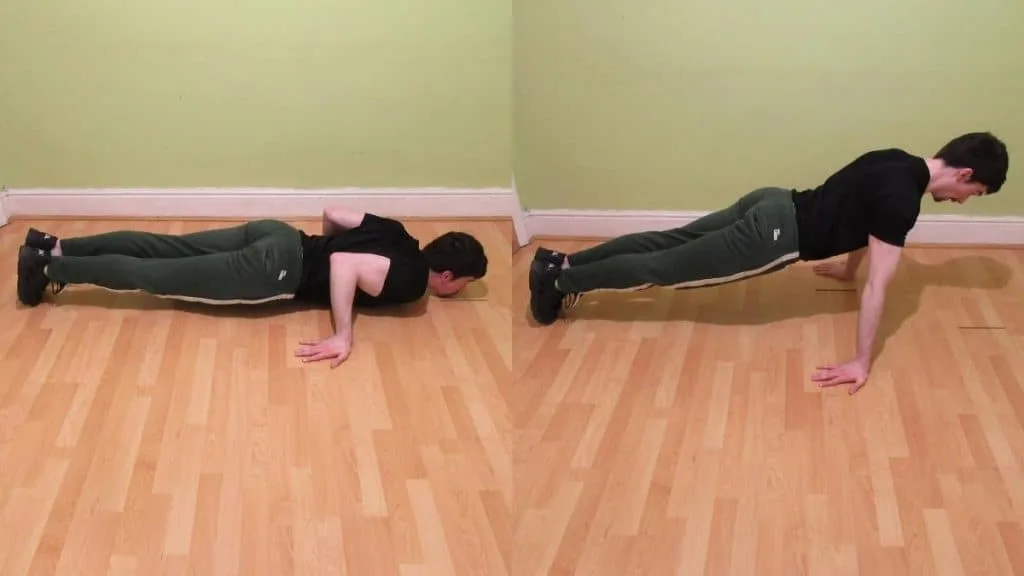
If you want to do a challenging biceps workout without weights or equipment of any kind, then you need to check out the biceps push-up.
This highly underrated exercise still trains your pushing muscles as well, but with a few minor yet challenging modifications, you can make your biceps work much harder than they would during regular push-ups.
To get the bicep-building benefits from this drill, you need to put your hands in a reverse position. So instead of facing forward, your fingers will be facing backward. You should also shuffle your hands back so that they’re closer to your ribs/hips rather than out in front of you. Lastly, make sure that your pelvis doesn’t dip. You need to maintain a hollow body position or, at the minimum, a neutral spine to maximize your bicep activation.
- Get into a regular push-up position and then rotate your hands so that your fingers are pointing toward you.
- Flare your hands out to the sides to reduce the pressure on your wrists.
- Shuffle your hands back so that they’re closer to your ribs/hips rather than your shoulders. Your torso will naturally come forward as you do this.
- Lower your chest toward the ground under control.
- Once your chest touches the floor, push yourself back up explosively until your elbows are locked out.
- Repeat for 3-5 sets of 8-20 reps. You can increase the difficulty by moving your hands even closer to your hips.
8. Curls with your leg
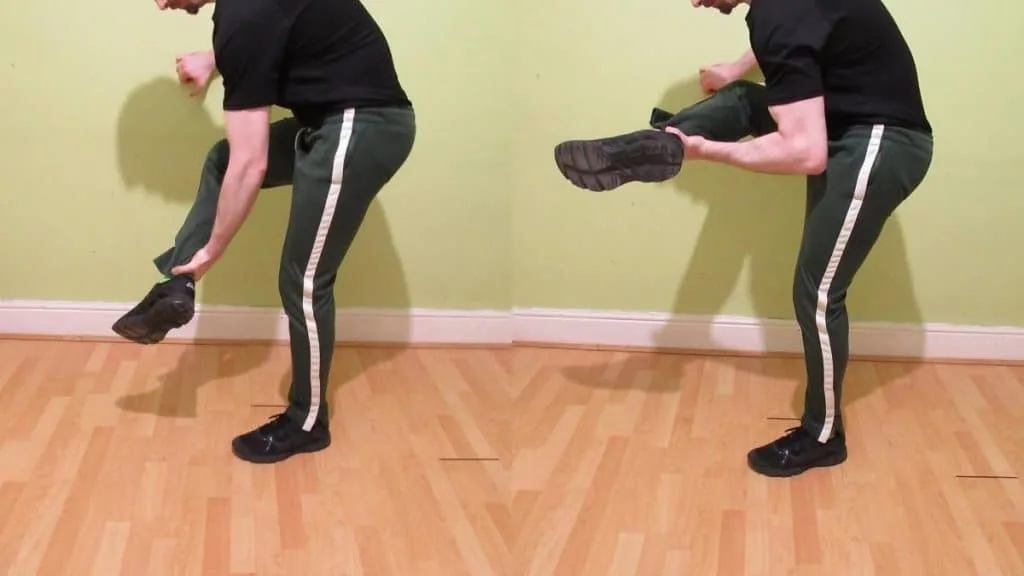
If you’re living a primitive life and don’t have access to a towel (or if you’re bored at work and have your gym bag handy), then you can also do bicep curls with your leg.
This is one of those no equipment bicep exercises that might seem pointless at first, but I’m telling you, after you’ve pumped out 30 reps, your biceps are really going to feel the burn.
You can even wear ankle weights to make your biceps work harder. And as you probably guessed, the bigger and heavier your legs are, the more challenging this movement will naturally feel. So let’s hope that you haven’t been skipping any leg days!
- Stand up straight and then bend over to grab your left leg with your right arm (or vice versa).
- Lift your leg toward your shoulder by contracting your biceps forcefully.
- Hold the contraction for a moment, and then lower your leg under control.
- Do the same for your other arm and perform 3-5 sets of 15-30 reps per side.
9. Bonus: TRX curls
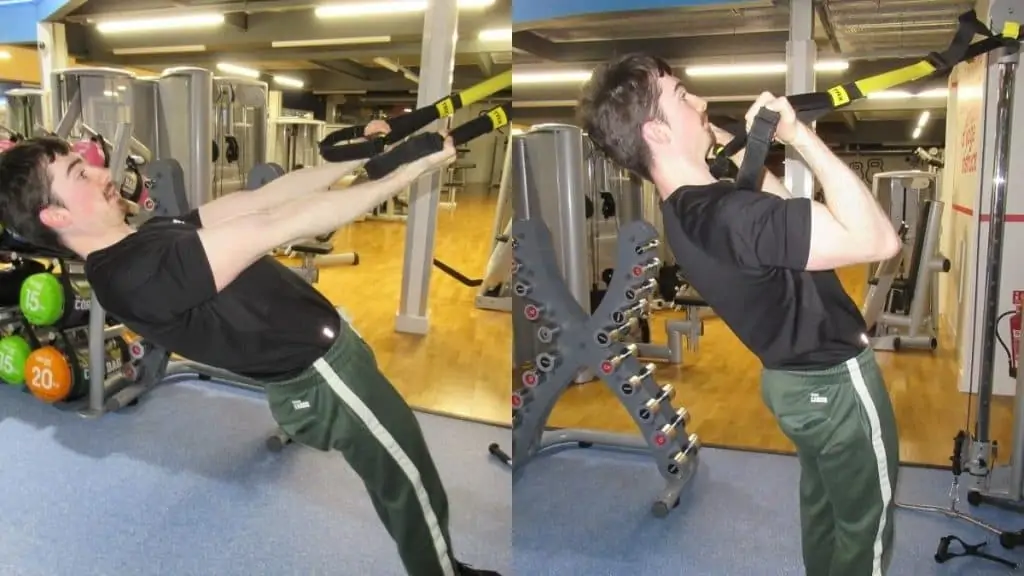
TRX bodyweight curls can really increase the mass of your biceps. And since you’re lifting your body for resistance, almost anyone can perform them because the resistance is relative.
TRX curls are also a closed-chain exercise, which means that they put less pressure on your joints (presuming that you use good form) than free weight exercises.
You can even do a reverse grip TRX curl or hammer curls with a TRX if you want to train your brachialis and brachioradialis muscles in addition to your biceps. Doing Zottman curls with the TRX is another way to train these three major arm muscles at once.
Although you can definitely do this bicep exercise without weights, you will still need a suspension trainer to do TRX bicep workouts, so it’s not 100% equipment-free.
- Connect your suspension trainer to a secure attachment point above head height.
- Grab the handles with an underhand grip, and then step back until your arms are fully extended.
- Lean your torso back and shuffle your feet forward to create some resistance.
- Curl your head toward the handles while keeping your elbows, shoulders, and abs locked in place.
- Squeeze your biceps as hard as you can as they press up against your forearms.
- Lower your body under control until your arms are once again extended.
- Repeat for 3-5 sets of 8-15 reps.
Bicep workouts without weights
Now that we’ve shown you various bicep exercises without weights, it’s time to piece the individual movements together. So let’s explore the equipment-free workout routines that you can perform to blast your biceps. There are intense workouts for maximizing muscle growth as well as shorter sessions for getting a quick pump.
Workout 1: Quick and intense
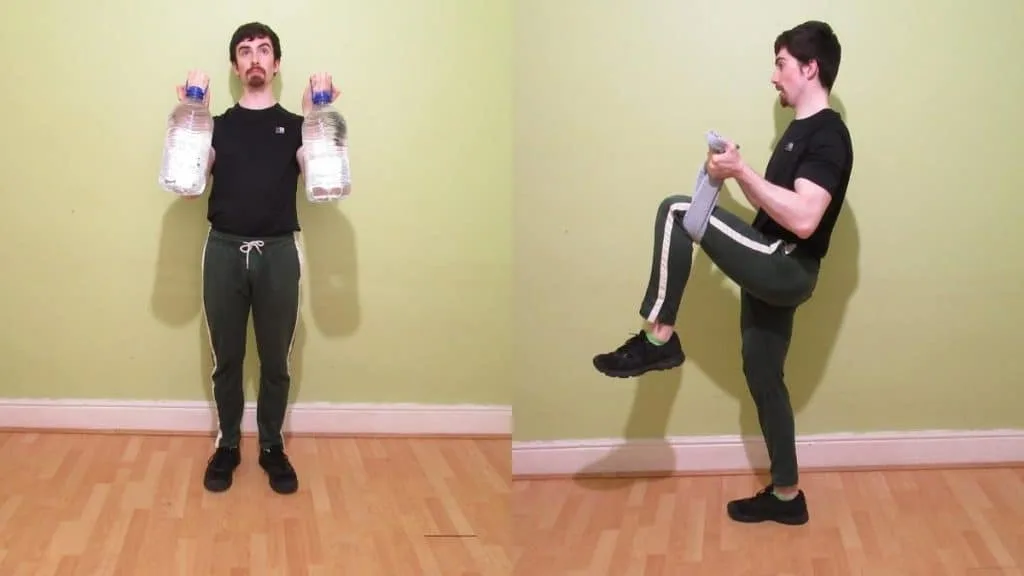
1: Water bottle curls — 3-5 sets of 10-20 reps
2: Towel curls — 3-5 sets of 15-30 reps
3: Doorway curls — 3-5 sets of 20-50 reps
Doing your bicep workouts without equipment means that you need to be inventive. Thankfully, we already did the heavy lifting for you and took the guesswork out of building your biceps by coming up with three exercises that you can do to build bicep muscle.
All that you need for this workout is some heavy water bottles or milk jugs and a towel. Yes, that might mean going to the store to get some bottles, but the effort will be worth it because these things can weigh as much as heavy dumbbells.
Rest 30-60 seconds between sets. The aim of this particular workout is to stimulate hypertrophy via metabolic stress, [1] so you need to stay close to muscular failure by keeping your rest periods short in order to fatigue all the muscle fibers.
Workout 2: Zero Equipment

1: Curls with your leg — 3-5 sets of 20-50 reps
2: Door curls — 3-5 sets of 20-50 reps
3: Bicep push-ups — 3-5 sets of 8-20 reps
Performing this biceps workout at home without weights takes less than 15 minutes and requires zero equipment. That’s right; you don’t even need a towel this time.
Just make sure that you’re giving each set everything that you’ve got. Muscles respond to tension, so as long as you’re training close to failure, you’re going to be stimulating hypertrophy of the biceps.
Rest 60-90 seconds between sets to keep the workout intensity high, or take longer breaks if you’re trying to gain strength.
Workout 3: Maximum hypertrophy
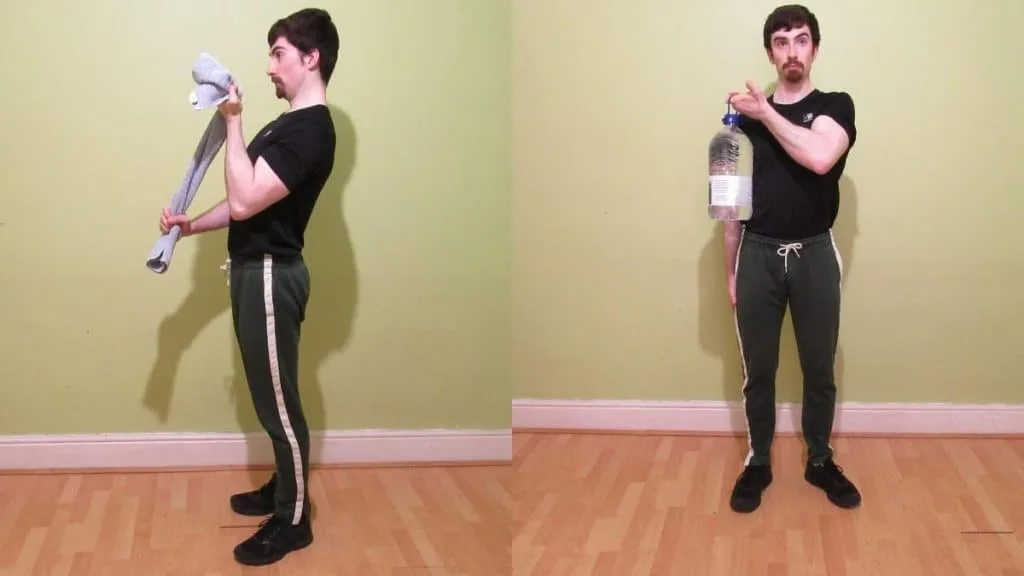
1: Water bottle curls — 3-5 sets of 8-15 reps
2: Single arm door curls — 3-5 sets of 10-20 reps
3: Backpack reverse curls — 3-5 sets of 12-15 reps
4: Vacuum cleaner hammer curls — 3-5 sets of 10-20 reps
5: Towel curls — 2 sets of 30-50 reps
It’s entirely possible to perform a no equipment bicep workout and still build enviable levels of muscle mass. But by using some everyday household objects, which don’t really count as gym equipment, you can keep yourself progressing—and your biceps growing—for months and years to come.
With water bottle curls, for example, you can simply add more liquid to increase the resistance. This is similar to graduating to the next pair of dumbbells at the gym and can really make your biceps strong.
You’re best off resting 1-3 minutes between sets (apart from the last exercise) so that you can accumulate enough training volume to stimulate hypertrophy. High rep training with short rest intervals certainly has its place, but when you’re training for maximum mass, you’ll be able to perform more total work (reps x sets x weight) when you put your pump-pride aside and rest a little longer.
You could even do supersets for your biceps with the above exercises if you want to save time. Note, however, that this back-to-back approach would mean performing fewer reps on your subsequent sets.
Workout 4: Strength
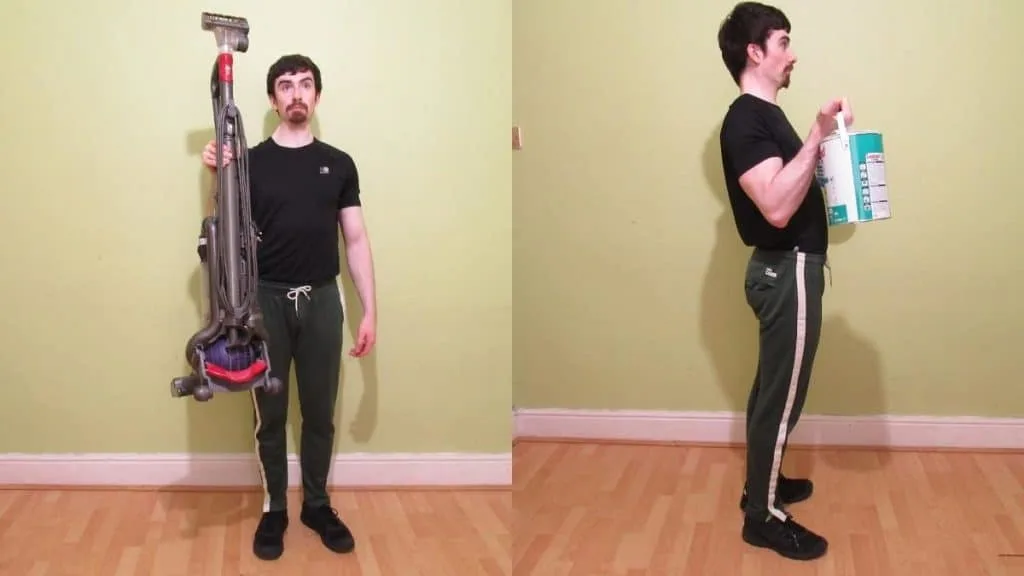
1: Milk jug curls — 3-5 sets of 6-12 reps
2: One arm doorway curls — 3-5 sets of 12-20 reps
3: TRX curl (or backpack curls) — 3-5 sets of 12-20 reps
4: Towel curls — 2 sets of 30-50 reps
Doing a bicep workout without equipment doesn’t mean that you’ll be saddled with weak and puny arms. By taking common exercises and making a few simple modifications, you can transform these weight-free movements and make them much more challenging.
Take door curs, for example. By performing them one arm at a time, you’re effectively doubling the resistance that your biceps need to handle. But it doesn’t stop there.
You can grab the doorframe with a pinch grip (i.e., between your thumb and fingers) rather than with the palm of your hands to tax your gripping muscles as well as your biceps.
Of course, wearing a weighted vest will instantly make each no equipment bicep exercise way more difficult, but it’s by no means a hard requirement for gaining strength.
Related Workout: Dumbbell bicep workout
How to get bigger biceps without weights
Now it’s time to learn how to get bigger biceps without equipment (and by equipment, we specifically mean gym equipment).
By being creative with your exercise selection, you’ll be able to work your biceps from multiple angles and stimulate optimal rates of growth.
Lift household objects
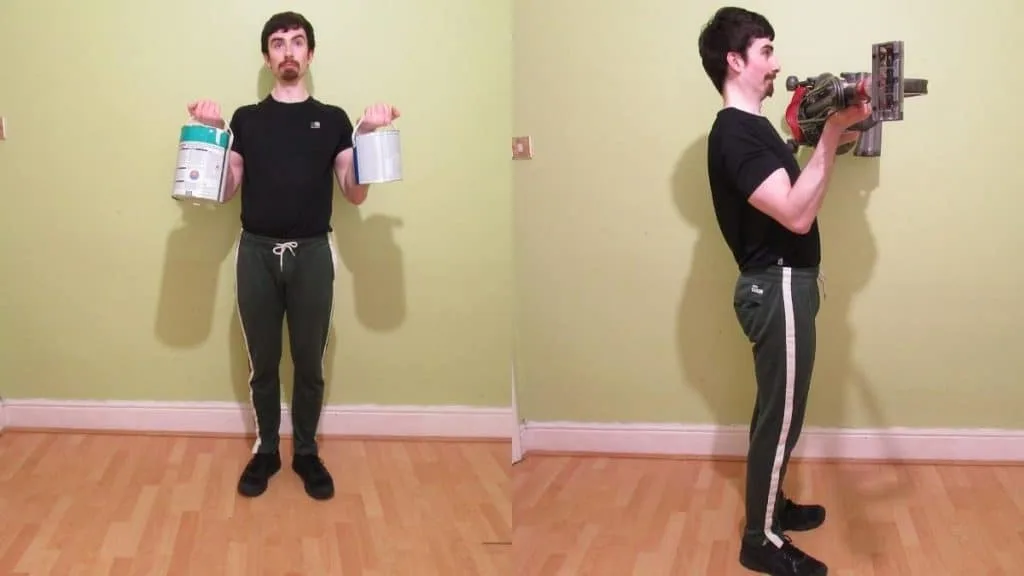
Doing household chores isn’t exactly a fun activity. But now that I think of it, that vacuum cleaner is kinda heavy. Maybe I could use it for bicep curls?
That’s how you look at household objects when you’re trying to build your biceps without weights!
Any item that you can grip and which has a decent mass to it—chairs, tins of paint, vacuum cleaners, crates of beer—will go a long way toward building your biceps.
Remember, there’s nothing inherently special about dumbbells and barbells besides the fact that they’re easy to grip.
It might seem counterintuitive to do curls with those step ladders or paint tins that are lying around, but such items will really give your biceps a good workout when you train hard (by which I mean close enough to failure).
Perform high reps

High reps can build just as much muscle as low reps when you train consistently and close enough to muscular failure. After all, as long as you’re challenging your biceps with tension of some kind, they’re going to grow bigger and become stronger with time.
But what if you’re already doing sets of 50 reps and above?
In this case, your best bet is to increase the time under tension by slowing down your repetitions.
Instead of performing the usual 1-2 second negative, try doing 4-5 second eccentrics to really make your biceps resist every ounce of tension. [2]
Of course, you can certainly do a low rep bicep workout without weights as well. The only complication is that you’ll need heavy milk jugs or paint tubs (or something similar) in order for you to have enough resistance.
A clever trick in this regard is to fill your milk jugs or bottles with sand rather than liquid since sand is denser than water. This is one reason why some weights are actually manufactured with a combination of sand and concrete. The other is because it’s cheaper, of course!
Eat enough protein, consume sufficient calories
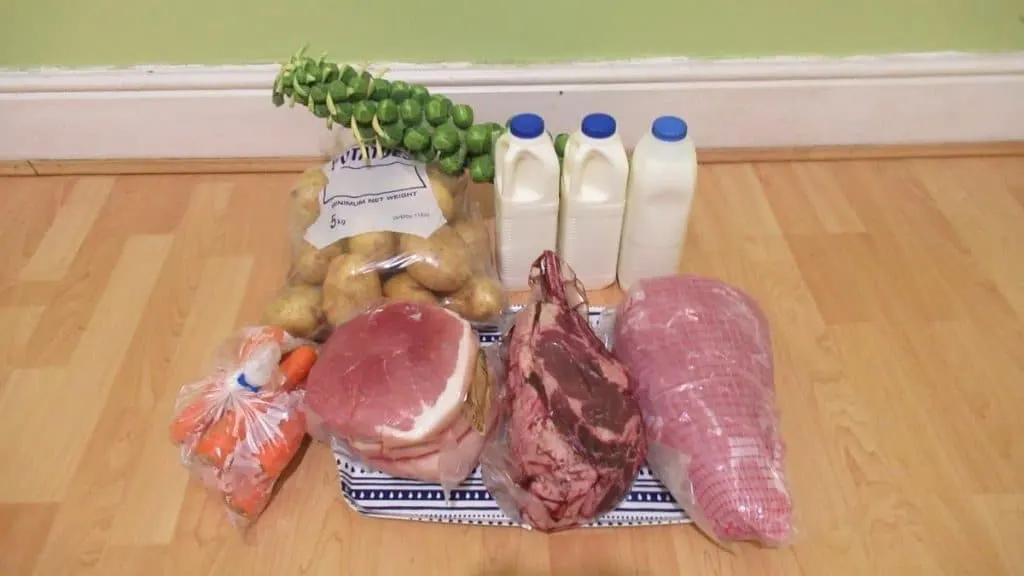
You can train balls to the wall every session, but if you’re not consuming enough protein or calories, then you won’t be making the most of your hard work. [3]
Aim to consume 1.8g of protein (or thereabouts) per kilogram of bodyweight. Protein is essential for building muscle, yet it also helps our organs, bones, and skin to stay healthy, so it’s not a nutrient that you should skimp on.
This is especially true if you’re lifting weights regularly because strength training increases protein requirements.
If you’re training for mass, then it’s also worth eating in a 10-20% calorie surplus so that the extra energy, which your body derives from the food, can be put toward new muscle growth.
Train closer to failure

Although total training volume over the course of the session, week, and mesocycle is what primarily determines rates of muscle growth, you need to train pretty close to failure (leave no more than 2-3 reps in reserve) if you want to make your sets effective.
So let’s say that you have a weight and, gun to your head, you could do 10 reps at the most. In this case, you’d need to be doing at least 7 reps per set to recruit as many muscle fibers as possible.
Of course, as your workout progresses, that 10 rep max might become a 7 or 8 rep max due to fatigue. In which case, you’d do a minimum of 5 or 6 reps, respectively.
As a general rule of thumb, the closer that you train to muscular failure on each set, the fewer total sets that you need to do. So basically, you just need to decide whether you prefer shorter and more intense bicep workouts without equipment or if you’d rather do longer and generally less taxing training sessions.
See Also: At home forearm workout
Conclusion: How to get big biceps without weights
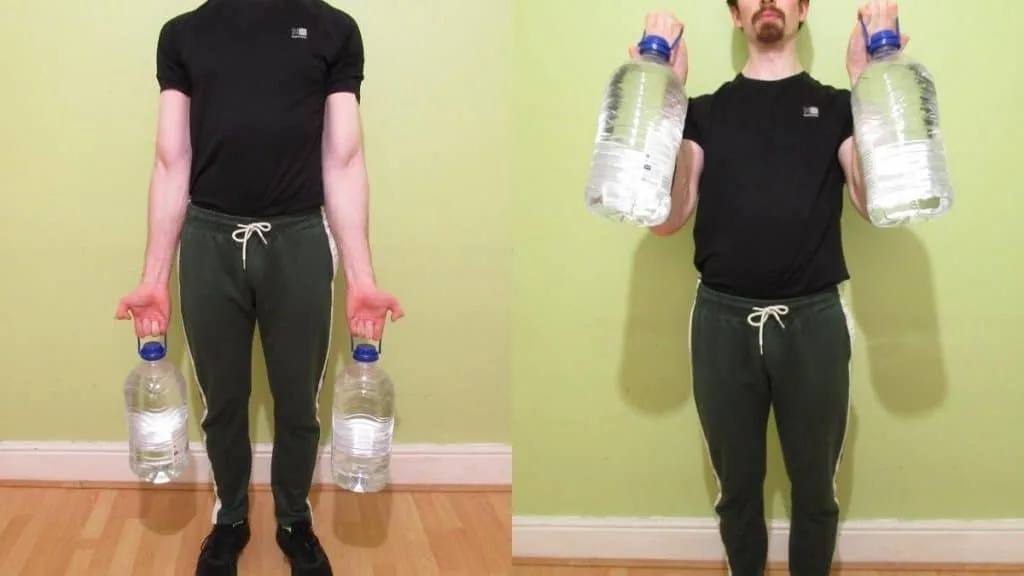
As you hopefully learned, performing challenging bicep workouts without weights or gym equipment is completely possible. The key is to be creative and remember that you can use virtually any object for resistance as long as you can grab it comfortably. So don’t think that you need to buy expensive gym gear if you’d rather work out with household objects and basic equipment.
References
- Schoenfeld, B. J. (2013). Potential Mechanisms for a Role of Metabolic Stress in Hypertrophic Adaptations to Resistance Training. Sports Medicine, 43(3), 179–194. https://doi.org/10.1007/s40279-013-0017-1
- Wilk, M., Zajac, A., & Tufano, J. J. (2021). The Influence of Movement Tempo During Resistance Training on Muscular Strength and Hypertrophy Responses: A Review. Sports Medicine, 51(8), 1629–1650. https://doi.org/10.1007/s40279-021-01465-2
- Phillips, S. M. (2010, November 22). The science of muscle hypertrophy: making dietary protein count | Proceedings of the Nutrition Society. Cambridge Core. https://www.cambridge.org/core/journals/proceedings-of-the-nutrition-society/article/science-of-muscle-hypertrophy-making-dietary-protein-count/F0E5C7D9AA3C5385287C806EE504E18E

